DSC03088

.« Pirssure Distribution in a Fluid
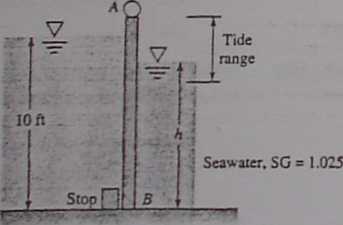
2.-U)>. What diameter of the sphere is just sufficient to kccp che gate closed?
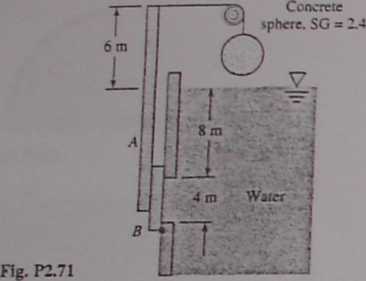
iii The V-shaped Container in Fig. P2.72 is hinged at A and held together by cable BC at the top. If cable spacing is 1 ■ j m into the paper, what is the cable tension?
Cable
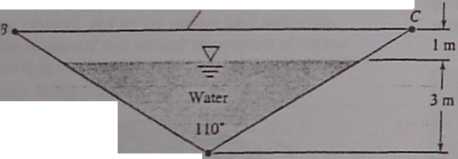
Fig.P2.72
3 Gate AB is 5 ft wide into the paper and opens to let fresh water out wfaen the ocean dde is dropping. The hinge at A is 2 ft above the freshwater Ievel. At what ocean Ievel h will the gate first open? Neglect the gate weight.
Fig.P2.73
4 In "soft” liąuids (Iow bulk modulus p). it may be necessary to account for liquid compressibility in hydrostatic calcu-lations. An approximate density reiadon would be
dp ~ - dp = ar dp or p *• p0 + SM - Po)
P
where a is the speed of sound and (p„, p^) are the conditions at the liquid surface z = 0. Use this approximation to show that the density variation with depth in a soft liquid is
p 1
where g is the acceleration of gravity and z is positive up-ward. Then consider a vertical wali of width b. extending from the surface (z = 0) down to depth z — — h. Find an analytic expression for the hydrostatic force F on this wali, and compare it with the incompressible result F = Poghrb/2. Would the center of pressure be below the incom-pressible position z = -2A/3?
2.75 Compute the force on one side of the parabolic panel ABC in Fig. P2.75, neglecting atmospheric pressure. Compute the vertical distance down to the center of pressure, given that 4* = 2A/P/7 for a parabola about a horizontal axis through A.
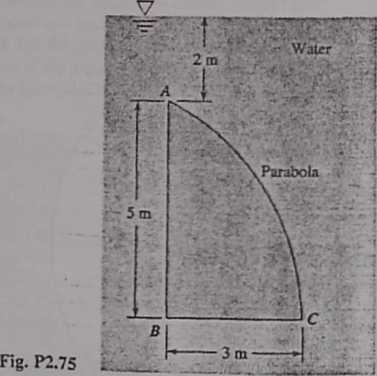
2.76 Consider the angled gate ABC in Fig. P2.76, hinged at C an o width b into the paper. Derive an analytic formula
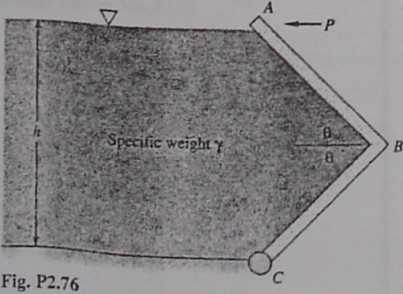
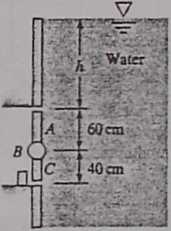
2.82
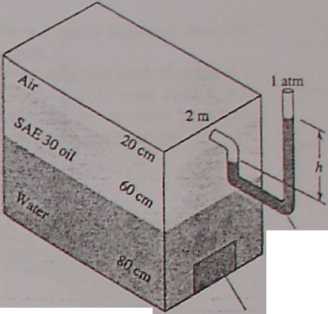
Macury
Panel, 30 cm high. 40 cm wide
for the horizontal force P requirsd at the top for eąuilibrium, as a function of the angle 0. .
2.77 The circular gate ABC in Fig. P2.77 has a 1-m radius and is hinged at B. Compute the force P just sufficient to keep the gate from opening when h = 8 m. Neglect atmospheric pressure.
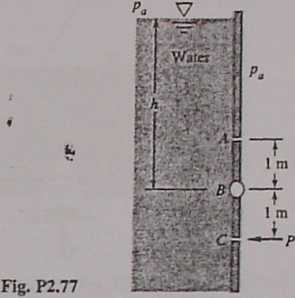
2.78 Repeat Prób. 2.77 to derive an malytic expression for P as a function of h. Is there anythńg unusual about your solu-don?
2.79 Gate ABC in Fig. P2.79 is 1 m square and is hinged at B. It will open automaticaily when the water level h becomes high enough. Oetermine the lowest height for which the gate will open. Neglect atmospheric pressure. Is this result independent of the !iquid density?
Fig. P2.79
2JJ0 For the closed tank in Fig. P2.80, all fluids are at 20°C, and the airspace is pressurized. It is fbund that the net outward hydrostatic force on the 30- by 49-cm panel at the bottom of the water layer is 8450 N. Esdmate (a) the pressure in the airspace and (b) the reading h on the mercury mano-meter.
2.81 Gate AB is 7 ft into the paper and weighs 3000 lbf when submerged. It is hinged at B and rests against a smooth wali at A. Determine the water level h at the left which will just cause the gate to open.
Fig. P2J10
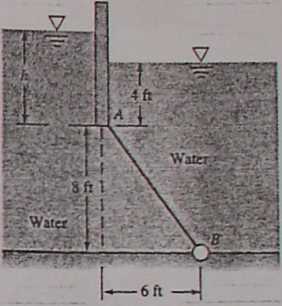
Fig.P241
The dam in Fig. P2.82 is a quarter circle 50 m wide into the paper. Determine the horizontal and vertical components of the hydrostatic force against the dam and the point CP where the resuhant strikes the dam.
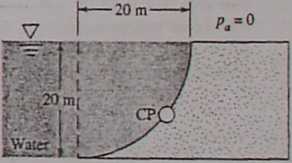
Fig. P2.82
2.83 Gate AR is a quarter circle 10 ft wide into the paper and hinged at B. Fmd the force F just sufficient to keep the gate from opening. The gate is uniform and weighs 3000 lbf.
2.84 Determine (a) the total hydrostatic force on the curved surface AB in Fig. P2.84 and (b) its linę of action. Neglect
AM
10 13:51
Wyszukiwarka
Podobne podstrony:
85317 slajd11 (95) QC3a. In your opinion, which of the following is best able to take effective acti
DSC03086 :w;Tv Distribuiion in j Fluid Find tr»c anilinie u w huh the pressure deviation is (u) I t
DSC03090 ‘*ł Pressure Distribuooo in a Fluid Fig. P2.99 atmospherfc pressure. compute the hydrostati
DSC03091 * jrr Distnbutioo in a Fluid 3.1* 10cm 5 cm i Comptue the ńetd-body rotadon ratę about its
00227 fa893f5d70e2a8634abfc718a817fdc 229Applications of the EWMA is scaled according to the percen
image255 Edit Rule Element[El Edit the rule element by choosing what major of the certificate is to
RecentTrends in Advertising I 2012 challenge of the marketer is to find a hook that will hołd the su
How to use ?Walnut has two joints. In this method, using the soft side of the walnut is very easy to
Rys103 The neutral performance models of the part is then subjected to various manufacturing analy
The Static of the Spheres is a work of fiction. The characters, incidents, dialogues, settings, even
bild1?9 SPARES. A porlion of the J.A.P. Works is givcn ovcr to holding a largo stock of replacement
bild1?7 SPARES. A portion of the J.A.P. Works is given ovcr to holding a large stock of replacement
64538 Ittman 09 PH YSICAL CULCURŁ ANO BREATHINO. £xercise No. 2. Development of the forearm—It is ju
DSC03089 PresMłrt DisłnNjocc in a Fluid Fig. P2JS4 atmospberic pressure, and let tbe surfacc hm unit
21 In principle the agglomeration of the nomands is not large, it counts some twenty to eighty perso
więcej podobnych podstron